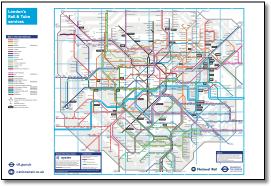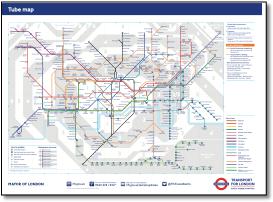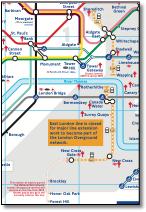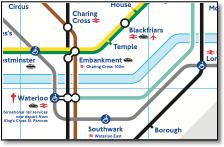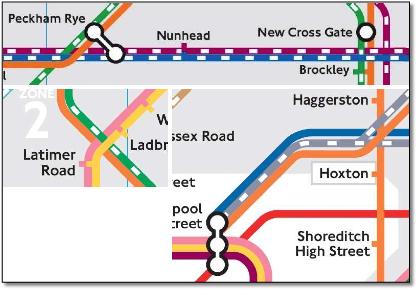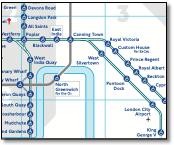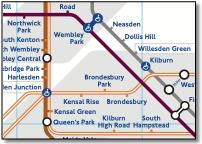 |
||||||||||||||||
|
|||||
|
|
||||
|
 |
|
|||
|
|||||
|
|||||
|
|||||
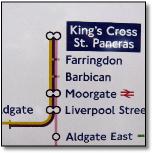 |
||
And now they've introduced the new disabled symbol, is it a station or an interchange station? It just emphasises the problem and draws the eye to the DLR. Bank, Woodford and Waterloo look terrible. A very dubious bit of graphics this - there are so many other ways of doing this. For example, just use black ticks (better than using line colour anyway) and circles for inaccessible stations and red ticks and circles for those with disabled access. There are many poor layouts. For example, stations on radial arms are reasonably consistently spaced, whereas the stations between Morden and Stockwell are the most closely spaced, this is because there is too much space given to the Victoria-Stockwell-London Bridge triangle - all the stations in this area are more widely space than the central London area. Why does the Victoria line have to be so stretched here and why does the Jubilee line drop down so much for Southwark, it could quite easily be closer the Thames. What is the benefit in dropping the Central Line down at Bank and destroy the beautiful simplicity of a straight horizontal line? It is not like that geographically or necessary diagrammatically. The river could be brought closer at Blackfriars as there is a riverboat connection shown. The designer is working hard to keep station captions within zones, but this means double stacking some captions when they'd be more readable on one line (Hounslow East for example) and squeezing stations together (Kilburn Park to Warwick Avenue for example - although double stacking would have solved this - inconsistency of solution). There are lots of other poor renditions, bad alignment of interchange symbols at Waterloo, the New Cross Gate branch coming off the East London line without using the transition curve used elsewhere, an unnecessary bend in the DLR above West India Quay. Why drop the Hammersmith & City Shepherd’s Bush station down so far away from the Central Line station? This raises the issue of stations with the same name on different lines - what is the significance of the gap at Hammersmith compared with gap at Paddington? Why flush right Kensington Olympia over the station when centering is used elsewhere? You can't see the yellow tick at Aldgate - surely this is an interchange station just like Edgware Road? Farringdon should be slightly further down to look evenly spaced. The network should be the 'Underground', not the 'Tube' - or 'Metro'. |
||
|
||
The Londonist opinion : brand new maps brand new mistakes The new Tube and Rail Map replaces the Oyster rail map, which replaced the high frequency services map before it. It’s the result of an agreement hammered out between TfL and the Association of Train Operating Companies, and it should soon be showing up at every station in London, whether train, tube or tram. That’s a pity. Because it’s rubbish. It isn’t the fact that it’s ugly that’s the issue (although it is, astonishingly so). No, the problem is that it’s done away with whole chunks of useful information. For one thing, it’s oddly silent on how regularly the trains run, so that you can never be sure whether a line offers tube-level frequencies or one service a week. More importantly, though, it’s abandoned the practice of colour-coding lines based on which stations they run into. Instead, they’re coloured based on which train operating company (TOC) is currently running the things. North of the river, the routes only tend to go to one terminal anyway, so this doesn’t really matter (even if some of the colour choices suggest that the map was designed by a particularly poorly sighted bat). South of the river, though, it’s more problematic. The new map is helpful if you want to know which group of semi-competents are to blame for the cancellation of your train this morning (and we bet it’s Southeastern). But it’s not much use if you want to know whether you can get a direct train from Hither Green to Victoria. Which you can’t. But then, why would anyone need to know a silly little thing like that? It’s not all bad: the decision to colour-code by company will, at least, be useful for those whose season tickets are only valid on certain company’s trains. And the terminal-based system did seem unable to cope with the confusion caused by those trains that run into both London Bridge and Victoria. Nonetheless, it looks suspiciously like the new version has sacrificed information about London’s transport network that’s actually useful, in favour of sticking to the correct corporate brand identity. Because that, of course, is what really matters. Those of us who use the trains are, as ever, in no doubt as to where we come in the TOCs’ priorities. |
||||||
Project Mapping : more of the same from TfL So TfL beat ATOC when it came to design of the new map and TfL's old, tired format won out against the inovation in ATOCs Connections map. National Rail lines play second fiddle to tube routes - even to light rail and tram. Look at the title, tube comes first; look at the symbols, rail comes second. Described in the press release as 'a new, clear and combined map' it is hardly any different from previous versions, the excitement leading to the usual disappointment. The big issue as far as bloggers on the London Reconnections and The Londonist websites is colour coding the National Rail lines by train operating companies rather than by termini served. To some this is an improvement as there is a link with what people see at stations, the TOC corporate identity - the colour of the trains. It also leads to a lot of simplification with fewer lines and fewer colours. And 'filmstrip' styling versus 'tramline' styling for National Rail lines seems to be controversial. More important is the poor cartographic execution, the two biggest problems being the variable spacing between parallel lines and the inconsistent use of the interchange symbol. If anyone is looking for examples of why it is actually so bad, then look at West Croydon - why such a long connector? And Reeves Corner the wrong side of the Southern line. Why is Shadwell two blobs when Limehouse is one? And London Midland striking out on a new completely different route between Kilburn and Wembley! Waterloo & Waterloo East are one station? Arbitrary layer preference when lines cross. One gets the impression that TfL just rejects new ideas suggested by the many enthusiastic designers writing in on a regular basis. There is no debate, no open discussion, just more 'this is good for you'. Although I'm sure Pulse Creative are not complaining, good work for old mates. The importance of the iconic London tube map is too important to leave to TfL. |
||||||
|
||||||
